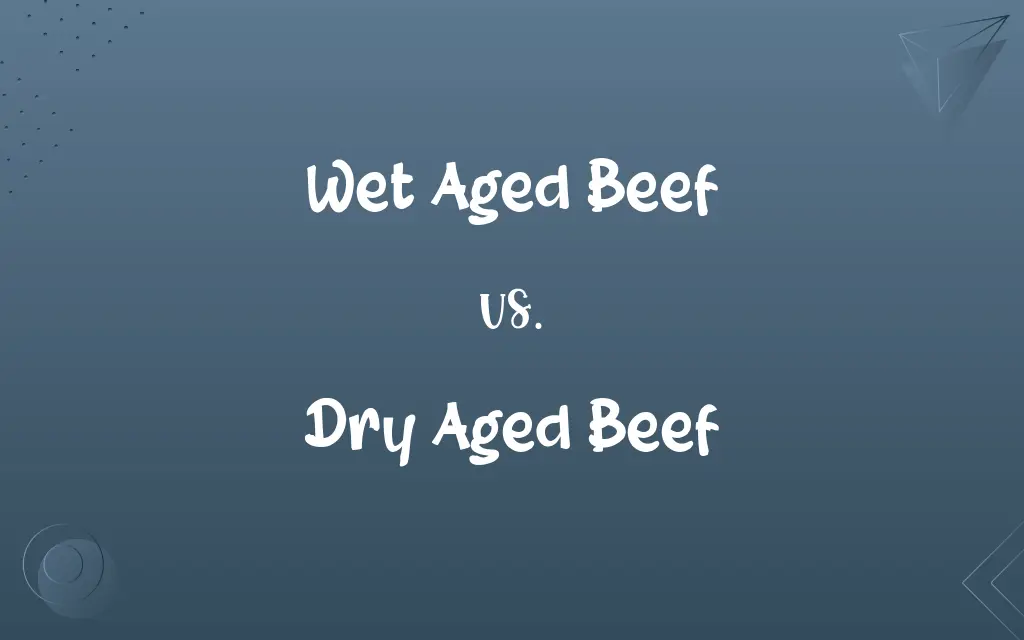Wet Aged Beef vs. Dry Aged Beef: Know the Difference

By Shumaila Saeed & Dua Fatima || Published on October 15, 2024
Wet aged beef is stored in vacuum-sealed bags to retain moisture, enhancing tenderness without altering taste. Dry aged beef is exposed to air, concentrating flavor and further tenderizing over time.

Key Differences
Wet aging beef involves vacuum-sealing the meat in plastic and allowing it to age in its own juices, typically for a period of a few days to several weeks. This process primarily tenderizes the meat without significantly changing its flavor. Dry aging, conversely, is the process of aging beef uncovered in a controlled environment, which not only tenderizes the meat but also intensifies its flavor by allowing moisture to evaporate and natural enzymes to break down the muscle fibers.
Shumaila Saeed
Oct 15, 2024
The environment for dry aging requires precise temperature, humidity, and air circulation control to prevent spoilage and encourage the development of a unique flavor profile. Wet aging, being sealed and refrigerated, doesn't require such specific conditions, making it more cost-effective and accessible for mass distribution.
Shumaila Saeed
Oct 15, 2024
Dry aged beef develops a crust on the outer surface, which is trimmed away, resulting in a greater loss of weight compared to wet aged beef. This, along with the longer aging process, makes dry aged beef more expensive than its wet aged counterpart.
Shumaila Saeed
Oct 15, 2024
The taste difference between the two methods is significant; dry aged beef offers a more pronounced beefy flavor with nutty and buttery notes, whereas wet aged beef maintains a cleaner, more straightforward beef taste. Consumers' preference often depends on their taste for the more intense flavor and texture that dry aging provides versus the subtler, tender qualities of wet aged beef.
Dua Fatima
Oct 15, 2024
Nutritionally, both methods maintain the beef's essential nutrients, though the concentration of flavor and tenderness differs. The choice between wet and dry aged beef often comes down to personal preference for texture and depth of flavor, as well as budget considerations due to the price difference.
Dua Fatima
Oct 15, 2024
ADVERTISEMENT
Comparison Chart
Aging Process
In vacuum-sealed bags to retain moisture
Exposed to air to allow moisture to evaporate
Dua Fatima
Oct 15, 2024
Tenderization
Enhances tenderness without altering flavor
Tenderizes and intensifies flavor
Shumaila Saeed
Oct 15, 2024
Flavor
Maintains a clean, beef taste
Develops a rich, concentrated beef flavor with nutty and buttery notes
Shumaila Saeed
Oct 15, 2024
Aging Environment
Does not require specific conditions
Requires controlled temperature, humidity, and air circulation
Dua Fatima
Oct 15, 2024
Cost
More cost-effective, less waste
More expensive due to longer aging process and weight loss from trimming
Dua Fatima
Oct 15, 2024
ADVERTISEMENT
Texture
Generally softer and juicier
Can become slightly firmer with a more pronounced texture
Shumaila Saeed
Oct 15, 2024
Shelf Life
Can be longer due to vacuum sealing
Shorter shelf life once cut due to exposure
Shumaila Saeed
Oct 15, 2024
Preferred Use
Preferred for standard, everyday beef consumption
Chosen for special occasions or by those seeking a gourmet experience
Dua Fatima
Oct 15, 2024
Nutritional Content
Preserves essential nutrients
Concentrates flavor, potentially altering perceived nutritional content
Dua Fatima
Oct 15, 2024
ADVERTISEMENT
Wet Aged Beef and Dry Aged Beef Definitions
Wet Aged Beef
More affordable and widely available.
Wet aged beef is a popular choice for its balance of quality and value.
Dua Fatima
Feb 25, 2024
Dry Aged Beef
Requires specific conditions for aging.
Their dry aged beef was stored in a custom-built aging room for optimal flavor.
Shumaila Saeed
Feb 25, 2024
Wet Aged Beef
Suitable for a variety of cooking methods.
From barbecuing to pan-frying, wet aged beef is versatile.
Shumaila Saeed
Feb 25, 2024
Dry Aged Beef
Offers a unique, intense beef taste.
Gourmets appreciate the complex flavors of dry aged beef.
Dua Fatima
Feb 25, 2024
Wet Aged Beef
Maintains a straightforward beef flavor.
He preferred the clean taste of wet aged beef for his family dinners.
Shumaila Saeed
Feb 25, 2024
Dry Aged Beef
More expensive due to the aging process.
The dry aged beef was a luxurious treat for special occasions.
Shumaila Saeed
Feb 25, 2024
Wet Aged Beef
Meat aged in its own juices to enhance tenderness.
The wet aged steak was tender and juicy, perfect for a quick grill.
Shumaila Saeed
Feb 25, 2024
Dry Aged Beef
Beef aged uncovered to concentrate flavor.
The dry aged ribeye had a deep, rich flavor unlike any other steak.
Shumaila Saeed
Feb 25, 2024
Wet Aged Beef
Vacuum-sealed to retain moisture.
Vacuum-sealed wet aged beef ensures a consistently tender product.
Dua Fatima
Feb 25, 2024
Dry Aged Beef
Ideal for those seeking a gourmet experience.
For an elevated culinary experience, he chose dry aged beef.
Dua Fatima
Feb 25, 2024
Repeatedly Asked Queries
Is wet aged beef less nutritious than dry aged?
Both methods preserve essential nutrients, but the flavor and texture differences do not significantly impact nutritional content.
Shumaila Saeed
Oct 15, 2024
Why does dry aged beef have a crust that needs to be trimmed?
The crust forms from exposure to air, which concentrates flavor but becomes inedible and must be trimmed before cooking.
Shumaila Saeed
Oct 15, 2024
Can I dry age beef at home?
Yes, but it requires careful control of temperature, humidity, and air circulation to avoid spoilage.
Shumaila Saeed
Oct 15, 2024
What makes dry aged beef more expensive than wet aged?
Dry aged beef requires a longer aging process, controlled conditions, and results in greater weight loss from trimming, increasing its cost.
Shumaila Saeed
Oct 15, 2024
Can you taste the difference between wet aged and dry aged beef?
Yes, dry aged beef has a more concentrated flavor with nutty and buttery notes, while wet aged beef maintains a cleaner, beef taste.
Shumaila Saeed
Oct 15, 2024
How long can you store wet aged beef compared to dry aged?
Wet aged beef, being vacuum-sealed, can have a longer shelf life than dry aged beef, which should be consumed shortly after purchase due to its exposure to air.
Shumaila Saeed
Oct 15, 2024
How does the aging process affect beef's tenderness?
Both aging processes break down muscle fibers, but dry aging also concentrates flavor due to moisture evaporation, affecting both tenderness and taste.
Shumaila Saeed
Oct 15, 2024
Can both aging processes be applied to the same cut of beef?
Technically, yes, but the cut would undergo either wet or dry aging, not both, as they achieve different results.
Dua Fatima
Oct 15, 2024
Is one aging process better for certain cuts of beef?
Preference varies; however, high-quality cuts like ribeye and sirloin are often preferred for dry aging to enhance their flavor and texture.
Shumaila Saeed
Oct 15, 2024
Are there any health risks associated with dry aged beef?
When properly aged in controlled conditions, there are no additional health risks compared to wet aged beef.
Dua Fatima
Oct 15, 2024
Why doesn't wet aged beef develop the same flavor as dry aged?
The vacuum-sealed environment of wet aging doesn't allow moisture to evaporate, so the flavor doesn't concentrate in the same way as dry aged.
Dua Fatima
Oct 15, 2024
What's the shortest aging period for noticeable flavor in dry aged beef?
A minimum of 21 days is often recommended for dry aged beef to develop a noticeable difference in flavor and texture.
Dua Fatima
Oct 15, 2024
Share this page
Link for your blog / website
HTML
Link to share via messenger
About Author
Written by
Shumaila SaeedShumaila Saeed, an expert content creator with 6 years of experience, specializes in distilling complex topics into easily digestible comparisons, shining a light on the nuances that both inform and educate readers with clarity and accuracy.
Co-written by
Dua Fatima








































































